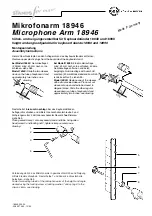
Revision 4
82
April 2020
Figure 51: Spectrum Curve Y-Axis Maximum Value Dialog Box
Enter in the desired maximum value for the Y-Axis scale (the minimum will always be zero)
and click on
Save.
Note that the normal maximum peak height for the spectrum curve is
around 28000-29000 A/D counts when the analyzer is in back-purge mode. The displayed
spectrum is updated once per second; to change to a static spectrum simply place a
checkbox into the
Stop Polling
checkbox. Once changed to a static spectrum, a specific
section of the X-axis can be zoomed into by left clicking and holding on the desired starting
pixel then dragging the green highlight that appears to the desired end pixel. After releasing
the left mouse button, the selected pixel range will expand to fill the whole graph field. The
zoomed in section will also be shown in green the
Panorama View
field, which shows an
overview of the entire collected spectrum. To return to the full spectrum, left click and hold
at the left side of the Panorama View field and drag the green area all the way the right side,
and the
Spectrum Curve
view will return to the full spectrum. To save the displayed
spectrum to a CSV file on the connected PC, click on the
Save Spectrum
button and saving
to the desired filename.
There are four numerical parameters displayed at the bottom of the
Spectrum Page
. These
parameters are described in Table 22.
Table 22: Spectrum Parameters
Parameter
Explanation
Spectrum
Peak
Displays the peak height of the spectrum, in A/D counts. Should be
approximately 28000-29000 when analyzer is in back purge mode.
First Vector
Pixel Level
Displays the intensity of light being received at the first vector pixel, in A/D
counts. The first vector pixel is the first pixel that is used for calculating
concentration values.
Dark Level
Displays the intensity of light being received when the spectrometer is dark
(i.e. no light present). This value should be in a range between 400 and 900
A/D counts.
Integration
Time
The integration time, or integration period, is the duration of time that light is
collected by the pixels of the spectrometer before being read by the control
computer. For example, in Figure 50 the integration time is given as 123.69
milliseconds. This means that the light incident on the spectrometer pixels
can accumulate for 123.69 milliseconds before being read by the control
computer; the spectrometer pixels are then zeroed and allowed to collect light
again. The displayed transmission spectrum, then, shows the intensity of light
collected at every pixel in this time period. Maximum value 1000ms.
The optimal integration time for the current analyzer conditions can be automatically
calculated by clicking the
Optimize Integration Time
button. Once clicked, the control
computer will adjust the integration time such that the peak height of the displayed spectrum
reads approximately 28000 A/D counts. If this peak height cannot be achieved even with a
maximum integration time of 1000 ms, this indicates a probl
em with the analyzer’s optical
system. Refer to section 7.2 for details on how to troubleshoot analyzer problems.
Содержание 943-TGX-CE
Страница 132: ...Revision 4 132 April 2020 Figure 81 Oven Cabinet Door Removed ...
Страница 133: ...Revision 4 133 April 2020 Figure 82 Control Cabinet Door Removed ...
Страница 134: ...Revision 4 134 April 2020 Figure 83 Power Steam Air Signals Connection Details ...
Страница 135: ...Revision 4 135 April 2020 Figure 84 AC Wiring Schematic ...
Страница 136: ...Revision 4 136 April 2020 Figure 85 DC Signals and Wiring Diagram ...
Страница 137: ...Revision 4 137 April 2020 Figure 86 Flow Diagram ...
















































